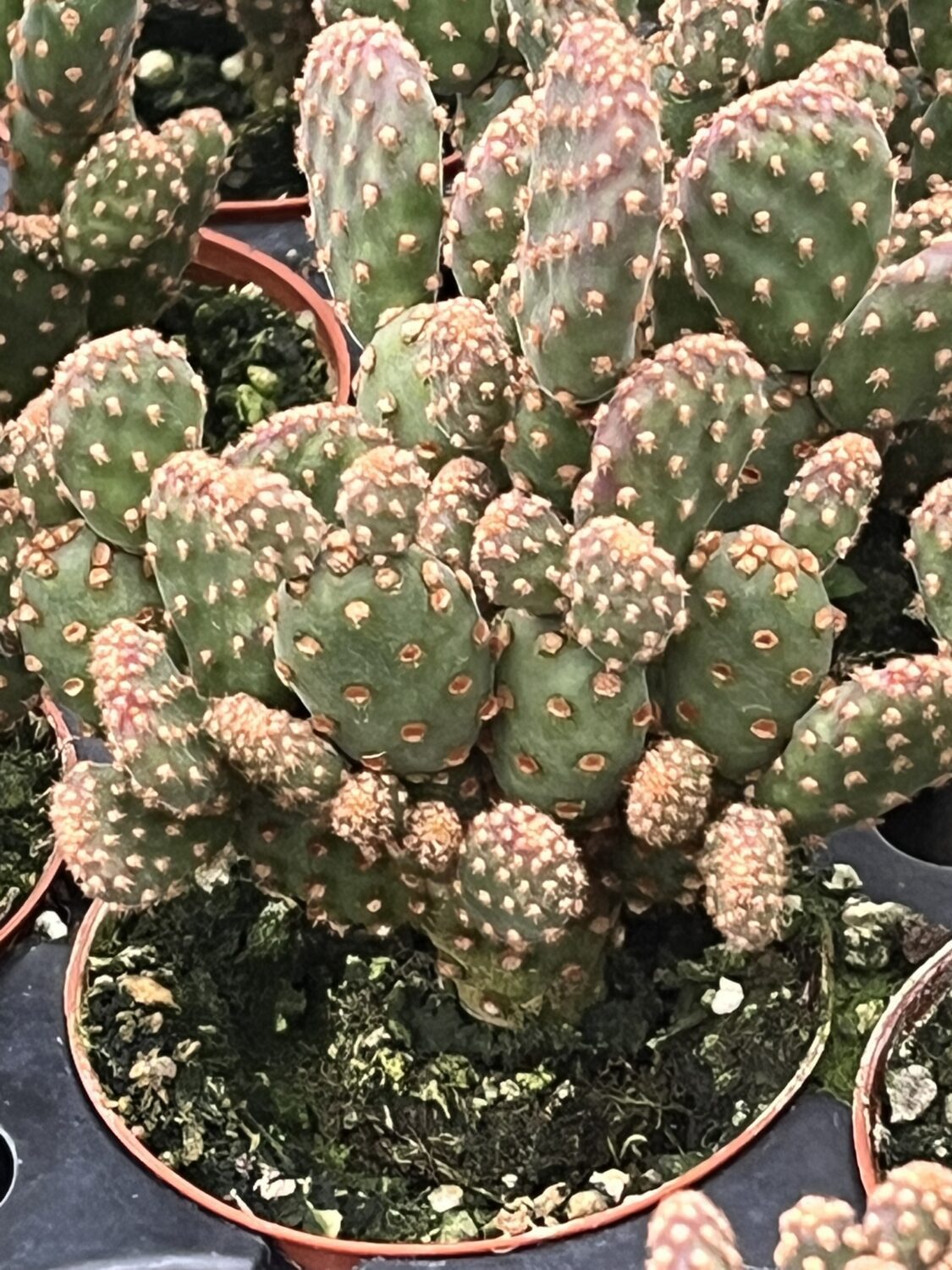Opuntia rufida minima monstrose ‘Cinnamon Cactus’
Price range: $6.99 through $12.99
Hardiness Zone 9+
Discount per quantity
| Quantity | 3 - 8 | 9 - 14 | 15+ |
|---|---|---|---|
| Price | Price range: $6.78 through $12.60 | Price range: $6.57 through $12.21 | Price range: $6.29 through $11.69 |
| % Discount | 3% | 6% | 10% |

Description
Opuntia rufida minima monstrose ‘Cinnamon Cactus’: A Tiny Treasure with Big Charm
Opuntia rufida minima monstrose, often called the ‘Cinnamon Cactus,’ is a delightful miniature prickly pear cactus that instantly captures attention. Its warm, cinnamon-colored glochids — those tiny, hair-like spines — cover quirky, paddle-shaped pads that twist and turn in unexpected ways. The result? A plant that looks whimsical, sculptural, and a little wild, almost like a living bonsai straight from the desert.
This compact cactus is perfect for collectors and anyone wanting a standout piece for small spaces. Whether nestled in a container, placed in a rock garden, or featured in a desert-inspired landscape, the Cinnamon Cactus offers unique texture and color with surprisingly little upkeep.
Why the Cinnamon Cactus Stands Out
There’s no shortage of prickly pears in the cactus world, but this variety is something special. Here’s what makes it unforgettable:
-
Cinnamon Glow: The plant’s signature feature is its cinnamon-brown glochids, which add warmth and contrast to its green pads.
-
Compact and Quirky: This monstrose form grows irregularly, with pads that bend and branch in playful directions.
-
Drought-Ready: A true desert dweller, it thrives on minimal water and loves dry conditions.
-
Perfect for Pots: Its small size makes it an excellent choice for indoor growers or anyone with limited garden space.
-
Low-Maintenance Beauty: Once established, it’s one of the easiest cacti to care for.
Light: Sunlight is Essential
The Cinnamon Cactus loves the sun — the more, the better. Full sun helps it keep its compact form and rich color.
-
Outdoors: Aim for 6 to 8 hours of direct sunlight daily. South-facing spots work best.
-
Indoors: Place near a bright south- or west-facing window. If natural light is weak, use a grow light to supplement.
Without enough light, the pads may stretch, lose their warm tones, and become less attractive.
Soil: Keep It Fast-Draining
Good drainage is non-negotiable. This cactus hates soggy roots.
-
Use a cactus or succulent potting mix.
-
If using regular soil, mix in coarse sand, perlite, or pumice to improve drainage.
-
For outdoor planting, sandy or rocky soil is ideal. Raised beds or mounds can prevent water pooling after heavy rains.
Water: Less is More
Overwatering is the fastest way to harm this cactus. It stores moisture in its pads and needs time for the soil to dry between drinks.
-
Growing Season (Spring–Summer): Water every 2–3 weeks, letting soil dry completely between waterings.
-
Dormant Season (Fall–Winter): Water only once a month or less.
Always use the soak-and-dry method: water deeply, then let the excess drain away. Never let it sit in standing water.
Temperature and Humidity: Warm and Dry Wins
This cactus thrives in hot, dry climates and is hardy in USDA Zones 9–11.
-
Daytime: 70–100°F (21–38°C)
-
Nighttime: Keep above 50°F (10°C)
It tolerates occasional dips to the low 40s°F (5°C) but should be protected from frost. In humid areas, ensure good air circulation to prevent fungal problems.
Fertilizer: A Light Hand
Cacti don’t need much feeding, but a little boost helps during active growth.
-
Use a balanced cactus fertilizer diluted to half strength.
-
Apply monthly in spring and summer.
-
Skip feeding in fall and winter when growth slows.
Too much fertilizer can cause rapid, unnatural growth and spoil its compact shape.
Repotting: Slow and Steady
The Cinnamon Cactus grows slowly, so repotting is rarely needed.
-
Repot every 2–3 years or when it outgrows its pot.
-
Always choose a container with drainage holes.
-
Use fresh cactus soil when repotting.
-
Wear gloves or use tongs to avoid the irritating glochids.
Propagation: Start a New Plant from a Pad
Want more Cinnamon Cactus? Propagation is simple.
-
Use a sharp, clean knife to remove a healthy pad.
-
Let the cut end callus for 3–5 days.
-
Plant it upright in well-draining soil.
-
Water sparingly until roots develop in 2–4 weeks.
Pest and Disease: Rare but Possible
This cactus is tough, but keep an eye out for pests:
-
Mealybugs and Scale: Dab with alcohol on a cotton swab.
-
Spider Mites: Wipe pads with a damp cloth and improve airflow.
-
Root Rot: Avoid overwatering and always use draining soil.
Regular inspection helps catch problems early.
Styling and Design Ideas
The Cinnamon Cactus’s shape and color make it incredibly versatile in design:
-
Indoor Accent: Showcase in a terra-cotta or modern ceramic pot on a sunny sill.
-
Rock Gardens: Combine with other succulents and cacti for a desert vignette.
-
Miniature Landscapes: Great for dish gardens or open terrariums with gravel and stones.
-
Xeriscaping: Perfect for drought-tolerant outdoor designs with agaves, echeverias, and sedums.
Pairing it with plants of contrasting colors — like blue-gray echeverias or golden barrel cacti — creates striking displays.
A Plant That’s Easy to Love
Opuntia rufida minima monstrose ‘Cinnamon Cactus’ is more than just a quirky name — it’s a conversation starter and a joy to grow. With its warm tones, sculptural form, and forgiving nature, it’s perfect for anyone wanting a low-maintenance plant that still makes a big impact. Give it plenty of sun, minimal water, and a pot with good drainage, and it will reward you with years of charm and character.
Where Warm Hues Meet Whimsy
Few plants capture the playful side of desert gardening like the Cinnamon Cactus. It’s small but full of personality, demanding little yet giving so much visual reward. Whether you’re building a cactus collection or simply want something unique for your windowsill, this little gem is ready to steal the spotlight — one cinnamon-hued pad at a time.
Additional information
| Weight | N/A |
|---|---|
| Options | 2 in. (3 fl.oz.) Pot, 4 in. (16.9 fl. oz.) Pot |





